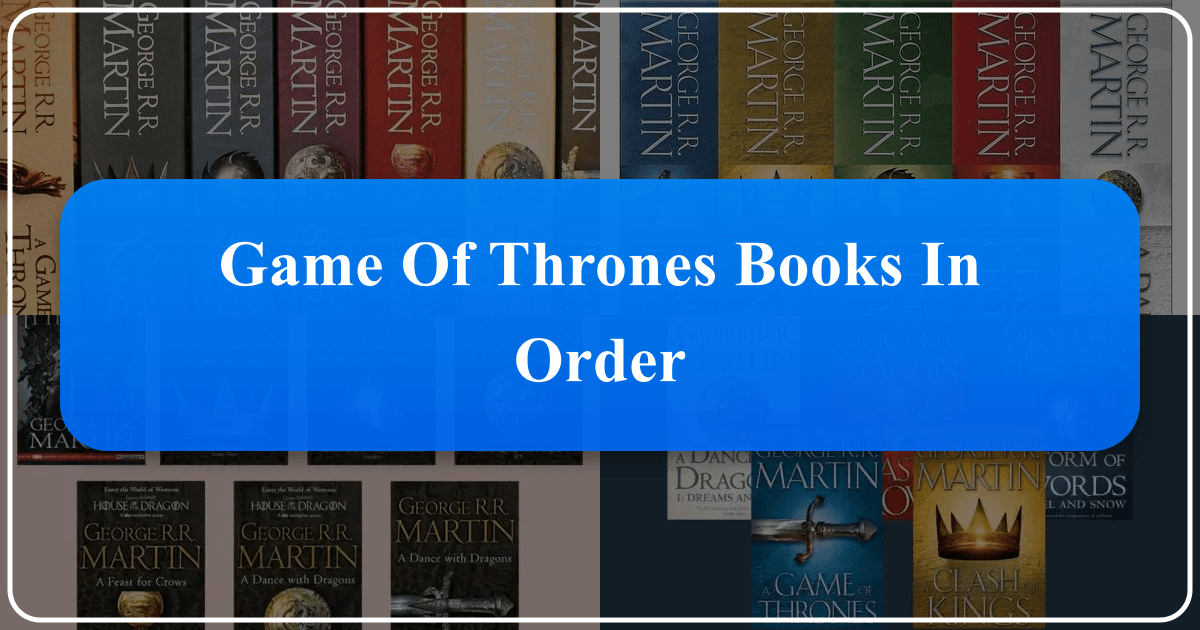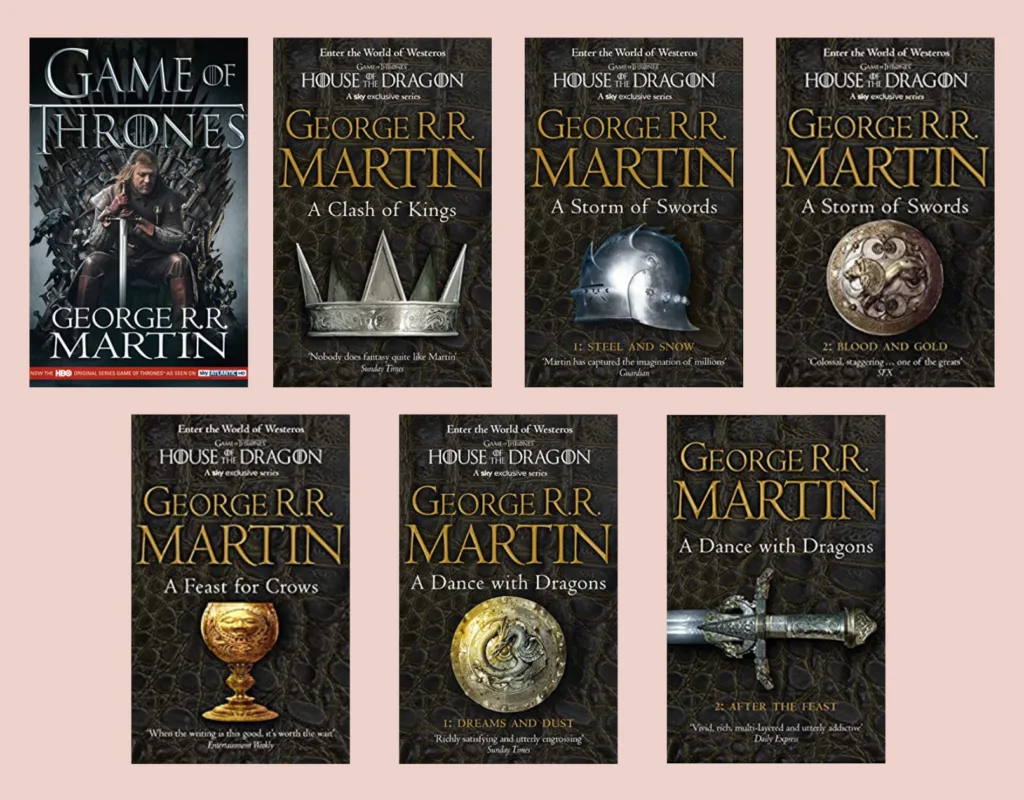Game of Thrones Books in Order: A Comprehensive Guide

George R.R. Martin’s A Song of Ice and Fire series, the inspiration behind HBO’s globally renowned Game of Thrones and its prequel House of the Dragon, has captivated millions with its intricate plots, complex characters, and unpredictable twists. To fully appreciate the depth and breadth of Martin’s world, understanding the order of the books is crucial. This guide will explore the series in detail, addressing reading order, individual book summaries, the author’s background, the cultural impact of the series, and related works.
Reading Order: Chronological vs. Publication
There are two primary ways to approach reading the A Song of Ice and Fire books: chronological order and publication order. Each offers a unique reading experience.
Chronological Order
Reading chronologically allows for a more cohesive understanding of the overarching timeline and the interconnected events across the series. This approach offers a more immersive experience, revealing character arcs and historical context as they unfold naturally within the story’s timeline. The chronological order is as follows:

Fire and Blood: This book, published in 2018, serves as a historical account of the Targaryen dynasty, providing crucial backstory for House of the Dragon. It covers three centuries of Targaryen rule in Westeros, laying the groundwork for many of the conflicts and familial relationships found in the main series. While not strictly necessary to understand the core A Song of Ice and Fire narrative, it greatly enriches the understanding of the Targaryens and their history.
A Knight of the Seven Kingdoms: This collection of novellas (previously released individually as Tales of Dunk and Egg) is set approximately a century before A Game of Thrones. It follows the adventures of Ser Duncan the Tall, a hedge knight, and his squire Egg (later Aegon V Targaryen). These stories offer a glimpse into a different era of Westeros, introducing characters and themes that subtly inform the main narrative while providing valuable insight into the Targaryen lineage.

A Game of Thrones: The first book in the main A Song of Ice and Fire series, published in 1996, introduces the core characters and sets the stage for the epic conflict to come. The story unfolds primarily in Westeros, focusing on the intrigues surrounding the Iron Throne and the growing threat from beyond the Wall.
A Clash of Kings: The second book, published in 1998, continues the story following the events of A Game of Thrones, escalating the conflicts and introducing several new key players. The War of the Five Kings is the primary driver of the narrative, showcasing the ongoing power struggles within Westeros.

A Storm of Swords: Published in 2000, this monumental installment expands the scope of the narrative, marking a turning point for many characters. The title aptly reflects the central theme of widespread conflict and brutal consequences.
A Feast for Crows: Published in 2005, this book shifts the narrative focus, primarily concentrating on characters in Westeros while offering a glimpse into the political machinations and power dynamics of the Seven Kingdoms.
A Dance with Dragons: Published in 2011, this installment further expands the geographical scope, connecting events in Westeros with those in Essos and showcasing the journeys of several key characters.
The Winds of Winter (Forthcoming): The sixth book in the series, eagerly awaited by readers worldwide, is still under development by George R.R. Martin.
A Dream of Spring (Forthcoming): The planned final installment of the main series, its completion remains a topic of much anticipation and speculation.
Publication Order
Reading in publication order mirrors the release timeline of the books. While this method preserves the author’s intended sequencing of revelations, it may lead to a less cohesive understanding of the complete timeline, as the narrative jumps across different times and geographical locations. The publication order follows the release dates:
- A Game of Thrones (1996)
- A Clash of Kings (1998)
- A Storm of Swords (2000)
- A Feast for Crows (2005)
- A Dance with Dragons (2011)
- A Knight of the Seven Kingdoms (2015, though the novellas were released earlier)
- Fire and Blood (2018)
- The Winds of Winter (Forthcoming)
- A Dream of Spring (Forthcoming)
Exploring the World of A Song of Ice and Fire
Book Summaries:
Each book in A Song of Ice and Fire presents a complex tapestry of interwoven storylines, focusing on various characters and their individual conflicts. The detailed summaries provided previously offer a comprehensive overview of the events in each book, giving you an understanding of their plots and character developments.
George R.R. Martin: Author and Inspiration
George R.R. Martin’s background as a science fiction and fantasy author greatly informs the creation of his epic world. His inspirations stem from a diverse range of sources, including historical fiction, mythology, and classic literature, all of which contribute to the intricate realism and fantastical elements of his novels.
Cultural Impact:
The A Song of Ice and Fire series has had a massive cultural impact, extending beyond its readership.
Literary Influence:
Martin’s writing style, blending high fantasy with gritty realism and morally complex characters, has significantly influenced the fantasy genre, paving the way for new authors and inspiring a wider interest in epic fantasy literature.
Adaptations:
The HBO television series Game of Thrones, along with its prequel House of the Dragon, brought Martin’s work to a global audience, increasing its popularity and solidifying its place in popular culture. Although the TV series deviated from the book series in some aspects, particularly in its final seasons, its visual spectacle and acting still made a huge impact on fantasy television.
Awards and Recognition:
A Song of Ice and Fire has received numerous accolades, reflecting its literary merit and influence. These awards and recognition across various platforms have demonstrated its popularity and success as a literary series.
Communities:
Dedicated online and offline communities thrive around the A Song of Ice and Fire series. These communities act as spaces for discussion and analysis, fostering creative expression and providing a platform for fans to connect and share their passion for the books.
Related Works:
Beyond the main A Song of Ice and Fire novels, additional works provide further exploration of Martin’s world:
Fire and Blood:
Previously discussed, this companion book provides a rich historical context for the Targaryen dynasty.
Tales of Dunk and Egg:
These novellas, offering prequel stories, introduce a different perspective on Westeros’s past, showcasing the adventures of Ser Duncan the Tall and his squire Egg.
The World of Ice and Fire:
A companion book offering a detailed history of the world of A Song of Ice and Fire, this source contains information on the geography, cultures, and history of the Seven Kingdoms, providing additional context for the main series.
Conclusion:
George R.R. Martin’s A Song of Ice and Fire stands as a monumental achievement in epic fantasy literature. Whether approached chronologically or by publication order, the journey through these novels offers an immersive and rewarding experience. With the anticipation for the remaining books still high, the cultural legacy of this series is sure to continue for years to come. This comprehensive guide provides a thorough overview of the books, their themes, their impact, and related works, equipping readers to embark on this epic journey informed and prepared for the complex world awaiting them within the pages.